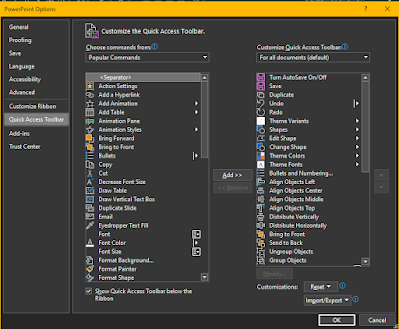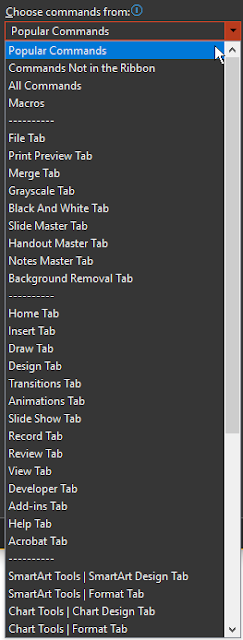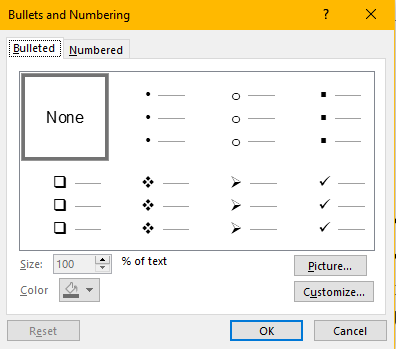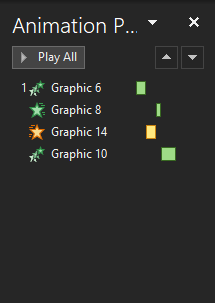Ever since I’ve been a marketer, PowerPoint presentations have been an important part of my work life. I italicize because I’m one of the few weirdos who LOVE making a PowerPoint to organize their thoughts and make their strategy come to life. I trained in graphic design, and I think that it’s probably linked to being creative and visual. I also feel more at home working in Photoshop or Illustrator. I’m used to layers, and guides. All dem guides *drools*.
Turns out, you can set up your workspace in a very similar way by leveraging a few easy tricks.
Customizing your Quick Access Toolbar
I’ll revert back to PowerPoint in a sec, I just needed the by default settings, don’t worry. It feels cold, here, in Excel.
Running back to safety… Now, if you click that little white down arrow next to the Undo button, you’ll get this:
First, I recommend showing the toolbar below the ribbon. Mine already is, so that’s why the screenshot says Show Above the ribbon.
Don’t forget to check the dropdown window at the top. It’s where you’ll be able to locate the settings you’re looking for beyond the “Popular Commands” category. It follows the ribbon you’re used to.
When I customized my Quick Access Toolbar, I took a minute to think about which tool I use the most often when I work in PowerPoint. And then, I scouted every tab and menu to see what options PowerPoint offers that I might’ve missed. This is my final result:
- I kept the saving options because it makes me less anxious to see them there
- Then, duplicate slide. I often use copy/paste for design, so I don’t want to have to lose my copied element by copy/pasting a slide if I need to.
- After comes our Undo/Redo combo. And then, the party begins. Go:
- Theme Variant
- Shapes
- Edit Shape
- Change Shape
- Theme Color
- Theme Font
- Bullet and Numberings…
- Align Objects Left
- Align Objects Center
- Align Objects Middle
- Align Objects Top
- Distribute Vertically
- Distribute Horizontally
- Bring to Front
- Send to Back
- Ungroup Objects
- Group Objects
- Alignment
- Center Vertically
- Outline Weight
- Graphics Fill
- Graphics Outline
- Guides
- Gridlines
- Pick Up Style
- Apply Style
- Slide Master view
- Close Slide Master view
- Insert Pictures
- Transparency
- Color
- Corrections
- Crop Tools
- Format Background…
- Hide Background Graphics
- Animation Pane
- Display the Selection Pane
Theme Variant
Here you’ll find all the different variants for Colors, Fonts, Effects and Backgrounds style. I have 1 different color theme saved for each brand I work for or work with. That way, my default colors are always the ones I need. I do the same thing for fonts.
This is my saved Colors, at the top. It’s easy to switch from one brand guide to the other when you have the options saved and one click away.
Shapes
The option is found under Insert > Shape. It … adds a shape.
Edit Shape
The option found under Shape Format, is only visible when a shape is selected. It gives you access to the selected shape’s endpoints and you can edit the shape for your needs. Think Pen tool or Illustrator.
Change Shape
The one is also found under Shape Format when you have a shape selected, but then it’s usually hidden under the Edit Shape button. It’s useful if yu decide you want to make your rectangle a circle in one clic.
Theme Color
Same as the option in Theme Variant, but 1 click closer.
Theme Font
Same as the option in Theme Variant, but 1 click closer.
Bullet and Numberings…
This version opens up the bullet and numbering dialog box, as indicated by the “…”. I personally like to work directly from the dialog box for these because you can customize them a little more from there. Customizing your bullet points to match your brand guideline is one super fast way of elevating your presentation design.
Change the color, but try to go beyond the usual culprits, too! Put an icon or an image. A part of your logo, maybe? Go crazy 😀
Align Objects Left | Align Objects Center | Align Objects Middle | Align Objects Top
These do exactly what they say. I feel like with these 4, I have about 90% of my alignment needs covered. I barely ever align right or bottom, for some reason. PS. If you select only 1 object, it will align it to the slide. 👍
Distribute Vertically | Distribute Horizontally
The day I discovered these, my life was never the same. It’s a very flexible and powerful tool. If you select 1 object, it will center it vertically or horizontally. If you select multiple objects, it will go from the higher (or most left) element to the lower (or most right) element.
Bring to Front | Send to Back
Will bring a selected object(s) on “top” of others or at the back of the pile. This is similar to how layers work in photoshop if layers were only used to stack objects.
Ungroup Objects | Group Objects
I ungroup more often than I group, that’s why I order them this way. I will often group a lot of things together, then when it’s time to tidy my design and align things properly, I’ll ungroup my general sections down to basic elements and then refine their alignments together.
Alignment
Similar to the alignments mentioned above, but for text. It has the text horizontal alignment, vertical alignment, cell, and text direction. Very useful.
Center Vertically
No big surprises here, but I like to have this one even 1 click closer from the options above.
Outline Weight | Graphics Fill | Graphics Outline
Another set of options that’s usually only accessible when you have a shape or graphics selected. For my use, these options are too often used to be hidden away in a contextual ribbon tab.
Guides | Gridlines
Here, it gets funky. These two are checkboxes to show or hide your guides and gridlines. You can customize the grid and add guide by right-clicking in your slide, and choosing the Grid and guides… option. Click on the words to access the dialog box or click the arrow to add guides.
Pick Up Style | Apply Style
Another little-known one, but oh so helpful. You know when you want all your text boxes to be the same, so you use the format painter tool? Pick Up Style does the same trick, but it holds it. And you can apply it with Apply Style as many times as you want until you pick up a new Style in the same presentation session.
Slide Master view | Close Slide Master view
If you don’t know what the Slide Master is, just know that it is where you can build a template to reuse and set a style that will apply to your whole presentation. I like to think of it as an InDesign for Dummies. And since I’m a dummy, I haven’t used InDesign to design in a loooong while. We’ll dig deeper some other time.
Insert Pictures | Transparency | Color | Corrections | Crop Tools
This is my image edition subsection. I think the functions are pretty self-explanatory again.
Format Background… | Hide Background Graphics
In this background subsection, I use the Format Background… to toggle the background pane on and have access to all the background options I could need:

Hide the background graphics is a checkbox that allows you to hide everything that came with the slide template and are only editable in the Master View. By ticking this box, you’ll hide everything that came with the theme. It’s useful for editing non-standard templated slides or when you need to start from a black slate but keep the layout of a slide.
Animation Pane
This option will open the right animation pane. I don’t often use animations, but when I do I like to control their flow and sequence, so this pane is very useful to get all up in the details.
Display the Selection Pane
I hope you found this helpful and learned a few things. Stay engaged, and good presenting!
%20(2).png?width=347&height=50&name=Ghetto%20Logo%20%20(500%20x%20317%20px)%20(2).png)















